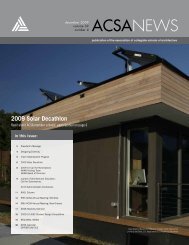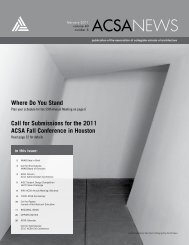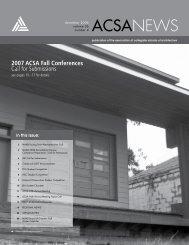digital aptitudes - Association of Collegiate Schools of Architecture
digital aptitudes - Association of Collegiate Schools of Architecture
digital aptitudes - Association of Collegiate Schools of Architecture
Create successful ePaper yourself
Turn your PDF publications into a flip-book with our unique Google optimized e-Paper software.
FRIDAY, MARCH 2, 2012 - 4:00PM - 5:30PM<br />
Digital Nouveau and the New Materiality<br />
Armando Montilla, Clemson University<br />
Digital Plecnik : Vienna Years<br />
Magdalena Garmaz, Auburn University<br />
This paper proposes that by looking at the work <strong>of</strong> the architects <strong>of</strong><br />
the Wagner School, Joze Plecnik in particular, one can identify a series<br />
<strong>of</strong> connective threads with the <strong>digital</strong> technologies <strong>of</strong> the present<br />
day. Digital technologies have enabled production <strong>of</strong> myriad<br />
<strong>of</strong> wall panel and cladding systems, with a focus on predetermined<br />
architectural form and materiality. It is important to state that the<br />
basic premise behind his architectural production remains true to<br />
Gottfried Semper’s Bekleidung theory, which provided the theoretical<br />
grounding to Plecnik’s work. Semper’s theory remains, even<br />
after a century and a half, as inspiring and fresh, as it was when it<br />
was first introduced to the architectural audience. In other words,<br />
Plecnik’s work embodies the same principles that were/are championed<br />
not only by Otto Wagner, but also by our contemporaries.<br />
Semper’s attention to the surface, or skin, rather than the structure<br />
<strong>of</strong> the wall, in relation to the space (making), found its early testing<br />
in Plecnik’s Vienna work. That same “Semperian cloth” richly<br />
adorned with architectural ornament, can be observed in the work<br />
<strong>of</strong> Swiss architects Herzog & de Meuron, who, with the help <strong>of</strong> <strong>digital</strong><br />
technology, create buildings that give an even more complex<br />
interpretation <strong>of</strong> the relationship between the surface and space.<br />
Material Postproduction<br />
Adam Fure, University <strong>of</strong> Michigan<br />
Material postproduction is an approach to working with architectural<br />
materials based on principles <strong>of</strong> manipulation, multiplication,<br />
and mixing. It draws from art theory, most notably Nicolas Bourriard’s<br />
text Postproduction and the writings <strong>of</strong> Simon O’Sullivan.<br />
Both writers articulate a model <strong>of</strong> art practice based on principles<br />
<strong>of</strong> connectivity, where establishing links between disparate objects,<br />
people, and practices is more important than creating original or<br />
autonomous art. Following these accounts, material postproduction<br />
advances a design approach that combines diverse materials,<br />
varied logics <strong>of</strong> application, and superficial alterations to create<br />
works <strong>of</strong> architecture that embody a broad range <strong>of</strong> cultural and<br />
disciplinary associations and experiential effects.<br />
Material postproduction is technological in nature but not founded<br />
on distinct technologies. Rather, new technology is used to expand<br />
architecture’s access to diverse types <strong>of</strong> matter. Material postproduction<br />
uses <strong>digital</strong> patterning to organize and interlace disparate<br />
materials producing heterogeneous aggregates. Superficial treatments<br />
are deployed to amplify visual and tactile depth and/or undercut<br />
the typical associations <strong>of</strong> common materials. In this way,<br />
both materials’ ability to transfer meaning and its physical status as<br />
raw matter are exaggerated and contaminated to produce diverse<br />
sets <strong>of</strong> associations and material qualities, yielding an experience<br />
that vacillates between the realms <strong>of</strong> the haptic, the visual, and the<br />
conceptual.<br />
Finally, material postproduction is opportunistically positioned in<br />
relation to architectural history. Past theories <strong>of</strong> architectural materiality<br />
are mined for latent relevance in contemporary contexts.<br />
Through the combination <strong>of</strong> seemingly oppositional strategies,<br />
material postproduction sets up relational approaches to design<br />
underwritten by a diverse set <strong>of</strong> concepts and material tactics. In<br />
doing so, material postproduction reactivates dormant disciplinary<br />
attitudes, imbuing vitality through insertion into new speculative<br />
domains.<br />
Nouveau Pulsation - 100 Years <strong>of</strong> Craft Evolution:<br />
From Art Nouveau to Digital Pulsation<br />
Eric Goldemberg, Florida International University<br />
This paper collapses 100 years between the intense deployment<br />
<strong>of</strong> ornament during the Art Nouveau period and the contemporary<br />
flourishing <strong>of</strong> ornamental, rhythmic production through <strong>digital</strong><br />
design and fabrication, speculating on the renewed potential<br />
for modulation systems to generate novel architectural tectonics<br />
and spatial effects. There is a complex and historical interrelation<br />
between ornament and techniques <strong>of</strong> architectural design and<br />
production that connects the turn <strong>of</strong> the 20th and 21st centuries.<br />
Ornament is considered here as the ultimate product <strong>of</strong> rhythmic<br />
perception, a locus for fecund architectural exploration.<br />
Pulsation generates ornamental effects that are not ad hoc, they<br />
are inherent to the rhythmic forces that activate dynamic changes<br />
in space, reflecting mutations and transition which get indexed on<br />
the tectonic connections within the range <strong>of</strong> topological geometry.<br />
Ornament, rhythmic awareness and new modes <strong>of</strong> craft triggered<br />
the concept <strong>of</strong> “Nouveau Pulsation”, a continuum <strong>of</strong> rhythmic geometries<br />
that brings together design sensibilities <strong>of</strong> two different,<br />
but intricately connected eras. The focus <strong>of</strong> Digital Nouveau is to<br />
highlight the shifting terrain <strong>of</strong> craft and ornament, as it has evolved<br />
from the 1900s until the present time. The comparison seeks a critical<br />
analysis and integration <strong>of</strong> a continuum <strong>of</strong> design production<br />
<strong>of</strong> 2 intense periods <strong>of</strong> approximately 15 years each, both <strong>of</strong> which<br />
articulated important transitions spanning 100 years, connecting<br />
the early 20th century with the early 21st century and the future.<br />
Contemporary <strong>digital</strong> practices and Art Nouveau share an interest<br />
in the spatial and aesthetic capacities <strong>of</strong> rhythmic affect coupled<br />
with ornamental form.<br />
Digital Apptitutes + Other Openings - Boston, MA - 25








